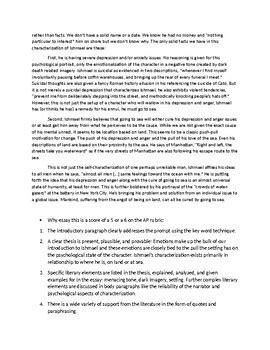For students aspiring to excel in the Advanced Placement (AP) Literature and Composition exam, mastering the art of essay writing is paramount. The AP Lit essay demands a nuanced understanding of literary texts, critical thinking skills, and exceptional writing abilities. This article provides a comprehensive guide to AP Lit essay examples to empower students with the tools and strategies necessary for success.

Key Components of an AP Lit Essay
A well-crafted AP Lit essay consists of several essential elements:
- Thesis Statement: A concise, arguable statement that presents the main claim or interpretation of the literary text.
- Textual Evidence: Specific quotations or paraphrases from the text that support the thesis statement.
- Analysis: An in-depth explanation of how the evidence supports the thesis statement, including insights into literary devices, themes, and characterization.
- Contextualization: A discussion of the literary text within its historical, cultural, or biographical contexts.
- Conclusion: A brief summary of the main arguments and a final reflection on the significance of the literary text.
Example Essay Topic: The Role of Symbolism in “The Great Gatsby” by F. Scott Fitzgerald
Thesis Statement:
In F. Scott Fitzgerald’s “The Great Gatsby,” the pervasive use of symbolism serves as a multifaceted tool to explore the complexities of the American Dream, the human condition, and the elusive nature of the past.
Body Paragraph 1: The Green Light
- Quotes: “A green light, minute and far away, that might have the power to focus a whole life, had drawn [Gatsby’s] eyes…”
- Analysis: The green light symbolizes Gatsby’s unattainable dream of Daisy and his desire to recreate the past. It highlights the futility of his pursuit and the impossibility of recapturing the past.
Body Paragraph 2: The Valley of Ashes
- Quotes: “This is a valley of ashes – a fantastic farm where ashes grow like wheat into ridges and hills and grotesque gardens…”
- Analysis: The Valley of Ashes represents the moral and societal decay of the 1920s. It contrasts the opulence of Gatsby’s mansion and serves as a reminder of the consequences of wealth and excess.
Body Paragraph 3: The Color Yellow
- Quotes: “Her hair, the color of an autumn leaf, turned gold, even in the dimmest candlelight…”
- Analysis: The color yellow is associated with vitality, optimism, and hope. It is often used to highlight Gatsby’s dreams and his pursuit of the American Dream.
Conclusion:
Fitzgerald masterfully employs symbolism to create a rich tapestry of meaning in “The Great Gatsby.” Through the green light, Valley of Ashes, and color yellow, he delves into themes of the American Dream, the human condition, and the elusive nature of the past. By analyzing these symbols, readers gain a deeper understanding of the novel’s complexities and its enduring relevance in American literature.
Additional AP Lit Essay Examples and Strategies
- “The Catcher in the Rye” by J.D. Salinger: Focus on the themes of teenage angst, alienation, and the search for innocence.
- “Hamlet” by William Shakespeare: Analyze the complex character of Hamlet, his motivations, and the tragic consequences of his decisions.
- “The Scarlet Letter” by Nathaniel Hawthorne: Explore the themes of sin, guilt, and redemption through the characters of Hester Prynne, Arthur Dimmesdale, and Roger Chillingworth.
- “The Crucible” by Arthur Miller: Discuss the historical context of the Salem witch trials, the role of mass hysteria, and the importance of due process.
Strategies for Success:
- Read the text attentively and annotate important passages.
- Develop a strong thesis statement that is specific, arguable, and supported by textual evidence.
- Use clear and concise language, and avoid unnecessary jargon.
- Cite specific examples from the text to support your analysis.
- Contextualize the literary text within its historical, cultural, or biographical context.
- Proofread carefully for any errors in grammar, spelling, and punctuation.
Tables to Enhance Essay Writing
| Component | Explanation |
|---|---|
| Thesis Statement | A specific, arguable claim that presents the main interpretation of the text. |
| Textual Evidence | Direct quotations or paraphrases from the text that support the thesis statement. |
| Analysis | An in-depth explanation of how the evidence supports the thesis statement, including insights into literary devices, themes, and characterization. |
| Contextualization | A discussion of the literary text within its historical, cultural, or biographical contexts. |
| Literary Technique | Definition | Example |
|---|---|---|
| Symbolism | The use of objects, colors, or actions to represent abstract ideas or concepts | The green light represents Gatsby’s unattainable dream. |
| Irony | A contrast between what is expected and what actually happens | Hamlet’s desire for revenge ultimately leads to his own downfall. |
| Imagery | Language that appeals to the senses | “Her hair, the color of an autumn leaf, turned gold, even in the dimmest candlelight…” |
| Foreshadowing | Clues that hint at future events | The appearance of the green light foreshadows Gatsby’s tragedy. |
| Contextual Element | Impact on Literary Text |
|---|---|
| Historical Context | Provides insights into the social and political environment that influenced the text |
| Cultural Context | Explores the artistic, religious, and intellectual influences on the text |
| Biographical Context | Examines the life and experiences of the author |
Conclusion
Mastering the art of AP Lit essay writing requires a combination of careful reading, critical thinking, and strong writing skills. By utilizing the examples and strategies outlined in this article, students can develop a deep understanding of literary texts and produce well-crafted essays that demonstrate their analytical and interpretive abilities. Remember, the key to success lies in practice, so engage with multiple texts, experiment with different approaches, and seek feedback from teachers and peers to continuously refine your writing proficiency.
